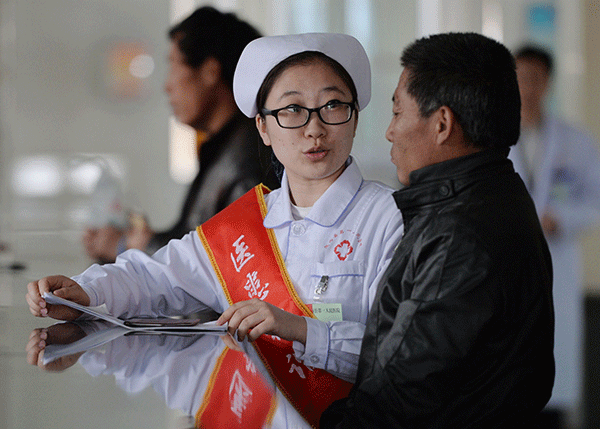Curing medical insurance ills
Updated: 2016-01-13 07:54
(China Daily)
|
||||||||
 |
|
A nurse explains how to claim reimbursement from the national medical insurance program in Longxi County No 1 People's Hospital in Gansu province.[Photo/Xinhua] |
China's medical insurance system is in trouble. Simply put, it will not make ends meet in a few years if no steps are taken.
The medical insurance fund has failed to keep up with the surging rise in medical expenses that have been growing at a double-digit rate each year. According to the Chinese Academy of Social Sciences, it is going to see a shortfall nationwide around 2020 at the latest if things continue as they are.
This has led to calls for people's contributions to the fund to be increased and for the government's contribution ratio to be raised. However, the latter has prompted concerns that it might put strain on government finances and even suggestions that it might later lead to "excessive social welfare". Yet such concerns are unwarranted because the level of social security in China remains low.
While it is no surprise that some experts have suggested people should have to contribute more to the fund, higher personal contributions seem unrealistic.
An average employee in the Chinese mainland already pays around 40 percent of his or her income for basic welfare that covers their medical care, pension, housing and unemployment insurance. This situation makes any talk of higher contributions from them impractical, and risks scaring away those who are yet to join the system.
Looking at the pockets of the general public should be the government's last resort.
However, there is still a lot that the government can do to make the medical insurance system sustainable, without increasing employees' contributions.
The administrative costs of the fund are many times more in China than in developed countries, leaving much room for improvement in terms of cutting costs and raising efficiency. This requires not only a high level of transparency in which the system is operated, but also markedly improved management skills.
- Spain's Princess Cristina stands trial on tax fraud charges
- Rupert Murdoch, Jerry Hall announce engagement
- Obama to deliver final State of the Union speech
- Annual Coming of Age Day ceremony held in Tokyo
- Drug lord closer to US trial as Mexico starts extradition process
- UN chief slams deadly attack on MSF-supported hospital in Yemen

 Photo studio takes people back in time
Photo studio takes people back in time
 Celebrities born in the Year of Monkey
Celebrities born in the Year of Monkey
 Remembering legendary British artist David Bowie
Remembering legendary British artist David Bowie
 Messi wins unprecedented fifth Ballon d'Or
Messi wins unprecedented fifth Ballon d'Or
 'The Revenant' and 'The Martian' big Golden Globe winners
'The Revenant' and 'The Martian' big Golden Globe winners
 The world in photos: Jan 4 - 10
The world in photos: Jan 4 - 10
 Creative designs create splash in Shanghai art center
Creative designs create splash in Shanghai art center
 Amazing ice wonderland in Beijing
Amazing ice wonderland in Beijing
Most Viewed
Editor's Picks

|

|

|

|

|

|
Today's Top News
Obama to deliver final State of the Union speech
Shooting rampage at US social services agency leaves 14 dead
Chinese bargain hunters are changing the retail game
Chinese president arrives in Turkey for G20 summit
Islamic State claims responsibility for Paris attacks
Obama, Netanyahu at White House seek to mend US-Israel ties
China, not Canada, is top US trade partner
Tu first Chinese to win Nobel Prize in Medicine
US Weekly

|

|








